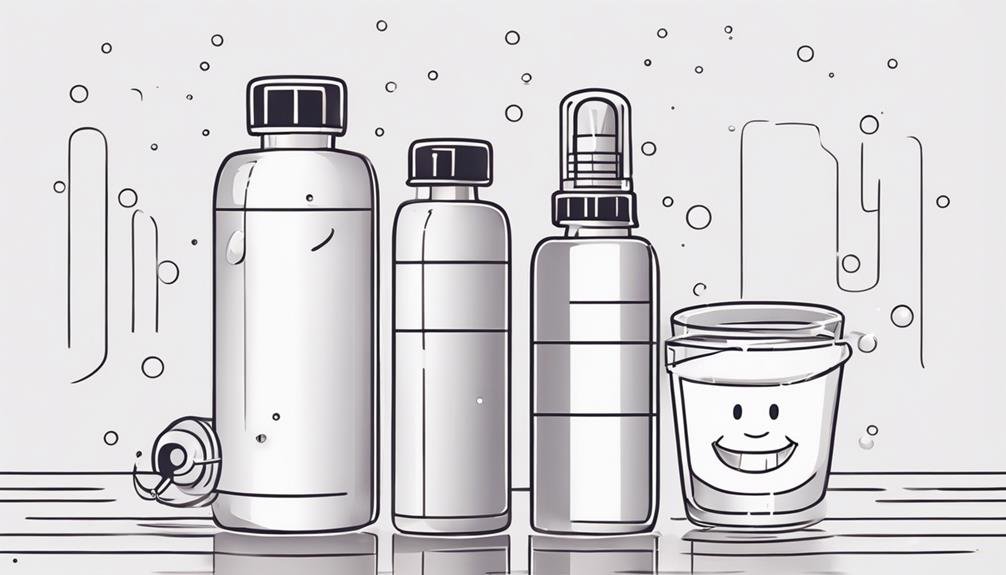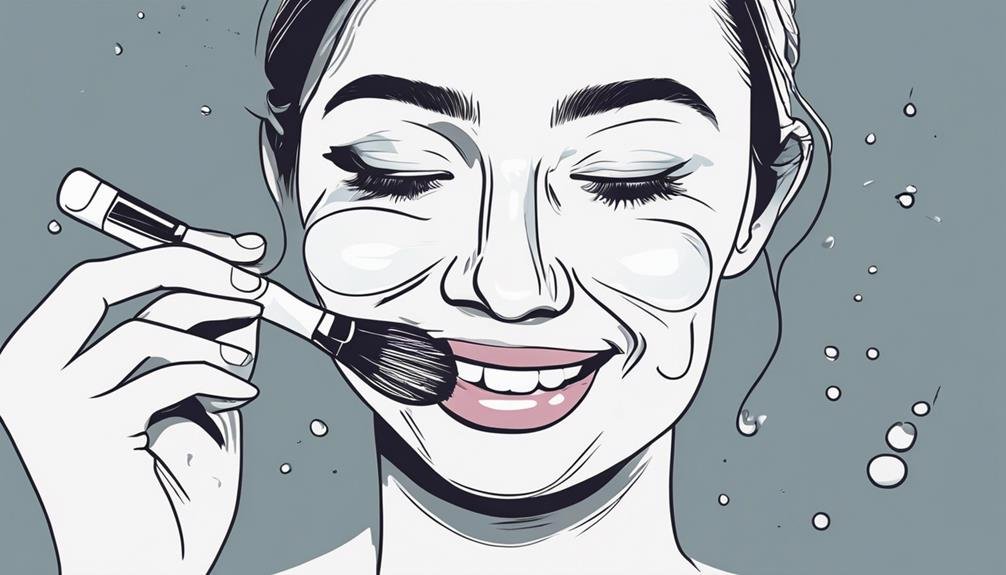If a sparkling smile is a window to your confidence, then mastering the hydrogen peroxide method could be your key to unlocking that radiance.
By exploring the potential of this DIY teeth whitening approach, you may uncover a natural solution that promises a brighter smile.
But before you take that first step, there are crucial aspects to consider that could impact your results significantly.
Intrigued to discover the secrets behind this method?
Key Takeaways
- Hydrogen peroxide is a safe and effective natural whitening agent used by dentists.
- Dilute it properly and avoid contact with sensitive areas for best results.
- Enhance its effects with baking soda or charcoal for a brighter smile.
- Consistency and proper aftercare are key to maintaining a whitened smile.
Benefits of Hydrogen Peroxide Teeth Whitening

Using hydrogen peroxide for teeth whitening offers a safe and effective solution to remove stubborn stains and maintain a bright smile.
Hydrogen peroxide is a natural whitening agent that can penetrate the enamel to break down and lift stains effectively. Its oxidizing properties help to whiten teeth by targeting discoloration caused by coffee, tea, red wine, and other pigmented foods.
Regular use of hydrogen peroxide can help you achieve a brighter smile over time, making it a popular choice for at-home whitening treatments. Additionally, dentists often use hydrogen peroxide in professional whitening procedures like Zoom whitening to ensure optimal results.
Mixing hydrogen peroxide with baking soda or activated charcoal can enhance its whitening capabilities, providing a cost-effective DIY solution for teeth whitening. With hydrogen peroxide, you can enjoy a brighter, more confident smile without the need for expensive treatments or harsh chemicals.
Safety Precautions for Using Hydrogen Peroxide
To ensure safe usage of hydrogen peroxide for teeth whitening, it's crucial to adhere to specific safety precautions.
Always dilute hydrogen peroxide with water to achieve a safe concentration between 1.5% to 3% for oral use.
Avoid swallowing the mixture and make sure to rinse your mouth thoroughly after whitening to prevent any potential irritation or sensitivity.
It's important not to apply hydrogen peroxide on damaged or sensitive gums as it may cause harm.
If you have dental restorations such as crowns or fillings, seek advice from a dentist before using hydrogen peroxide to avoid any adverse effects on these restorations.
Additionally, store hydrogen peroxide in a cool, dark place and ensure it's kept out of reach of children to maintain safety in your home.
Step-by-Step Guide to Using Hydrogen Peroxide

For effective teeth whitening with hydrogen peroxide, begin by thoroughly cleaning your teeth before application.
You can apply hydrogen peroxide directly onto your teeth or mix it with other whitening agents to create a paste.
Gently rub the hydrogen peroxide mixture on all tooth surfaces to ensure even whitening and effective removal of stains.
After a few minutes of application, rinse your mouth thoroughly to avoid any potential irritation.
If you have sensitive teeth, opt for lower concentrations of hydrogen peroxide to prevent discomfort while still achieving whiter teeth naturally.
Following these steps will help you achieve a brighter smile through natural whitening methods.
Remember to be consistent with your application for optimal results and to maintain good oral hygiene practices alongside your whitening routine for long-lasting effects.
Tips for Maximizing Results With Hydrogen Peroxide
Consider incorporating baking soda or charcoal when combining with hydrogen peroxide to enhance the whitening effects on your teeth. These ingredients can help to maximize the results of your DIY teeth whitening routine.
Here are some tips to help you make the most out of using hydrogen peroxide:
- Activated Charcoal: Mixing activated charcoal with hydrogen peroxide can help to absorb impurities and stains from the surface of your teeth, aiding in the whitening process.
- Baking Soda: Baking soda is known for its mild abrasive properties, which can assist in scrubbing away surface stains when combined with hydrogen peroxide.
- Make sure to rinse thoroughly: After applying the hydrogen peroxide mixture to your teeth, ensure you rinse your mouth well to remove any residue and prevent potential irritation.
Maintenance and Aftercare for Whitened Teeth

To maintain the brightness of your whitened teeth, incorporating a whitening toothpaste into your daily oral care routine is essential. Whitening toothpaste can help remove surface stains and prevent new ones from forming, extending the effects of your natural teeth whitening treatment. Additionally, it's important to avoid consuming staining agents such as coffee, tea, and red wine, as these can diminish the whiteness of your teeth over time. Regular dental cleanings are also crucial for removing surface stains and keeping your smile bright.
Consider scheduling touch-up treatments with hydrogen peroxide every few months to maintain a dazzling smile. These touch-ups can help boost the whiteness of your teeth and ensure long-lasting results. Alongside touch-up treatments, practicing good oral hygiene habits like brushing and flossing regularly is essential to prevent new stains from developing.
Remember to rinse your teeth thoroughly after consuming foods or drinks that may stain them and follow these maintenance tips to preserve your bright, white smile.
Frequently Asked Questions
What Is the Best Hydrogen Peroxide Concentration for Teeth Whitening?
For teeth whitening, the best hydrogen peroxide concentration ranges from 3% to 10%. Higher levels can cause sensitivity and harm gums. Dentists use stronger concentrations professionally. Lower levels are safer for DIY whitening.
What Is the Best Homemade Teeth Whitening?
For a dazzling smile at home, consider the lemon juice method, coconut oil pulling, or the charcoal powder trend. These natural remedies can help brighten your teeth without harsh chemicals, giving you a radiant grin.
How Long Does It Take Hydrogen Peroxide to Whiten Teeth?
To whiten teeth with hydrogen peroxide, apply it consistently as directed for 2-6 weeks. Results vary based on tooth discoloration. Long-term use can maintain brightness. Watch for potential side effects like gum irritation; ensure proper usage.
Is It OK to Brush Your Teeth With Baking Soda and Hydrogen Peroxide?
You can brush your teeth with baking soda and hydrogen peroxide. Baking soda benefits by scrubbing away stains, while hydrogen peroxide safely acts as a bleaching agent. These DIY whitening techniques offer a cost-effective way to brighten your smile.
Conclusion
In conclusion, mastering the hydrogen peroxide method for DIY teeth whitening can transform your smile with its powerful yet gentle effects. Like a painter carefully crafting a masterpiece, you can achieve a radiant smile that shines brightly for all to see.
By following the steps outlined in this guide and incorporating proper maintenance, you can confidently showcase your pearly whites with pride. Embrace the natural beauty of your smile and let it radiate with confidence.